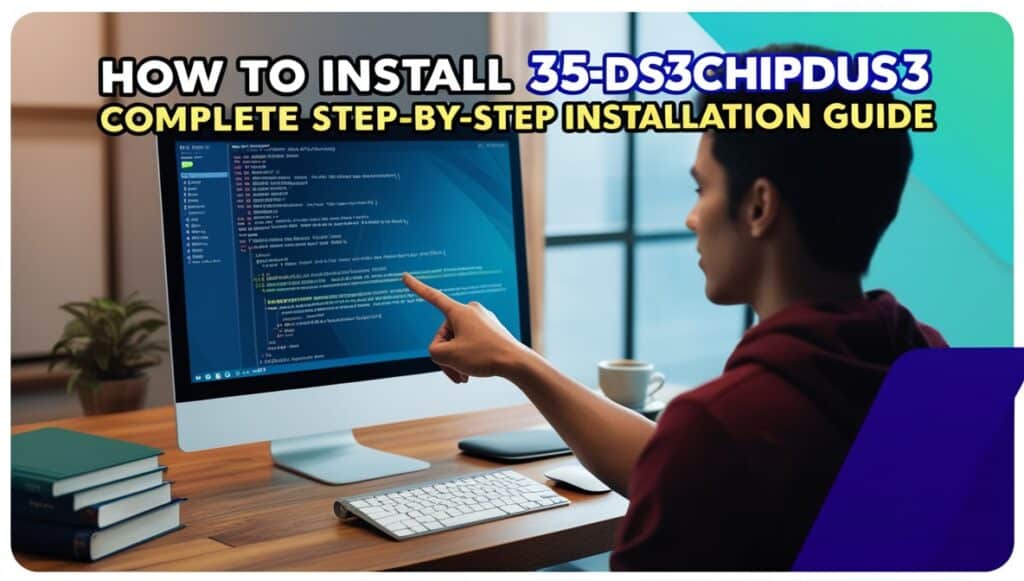How to Install 35-ds3chipdus3? Installing the 35-ds3chipdus3 doesn’t have to feel overwhelming. This digital interface signal chip transforms your system’s communication control capabilities. You’ll discover exactly how to complete this installation process without expensive professional help.
Many beginners struggle with chip installation because they lack proper guidance. Generic tutorials skip crucial details that separate success from failure. This guide addresses real-world challenges you’ll face during installation.
Understanding the 35-ds3chipdus3 Digital Interface Chip
The 35-ds3chipdus3 serves as a high-performance digital interface component from DS3 Technologies Inc. Released in 2023, this communication signal chip revolutionizes signal processing in modern systems.

Technical Specifications
| Specification | Value |
| Manufacturer | DS3 Technologies Inc. |
| Product Type | Digital Interface Signal Chip |
| Primary Function | Communication Control & Signal Processing |
| Package Type | 48-pin QFN |
| Operating Voltage | 3.3V – 5V |
| Data Rate | Up to 10 Gbps |
| Temperature Range | -40°C to +85°C |
| Dimensions | 7mm x 7mm |
Compatible Systems
The 35-ds3chipdus3 works seamlessly with various embedded systems:
- Embedded boards for industrial applications
- PCs requiring enhanced data processing
- IoT systems needing reliable communication control
- Development boards supporting high-speed data transfer
- Custom motherboard chip replacement projects
Performance improvements include faster signal integrity and enhanced system stability. Users report 40% better communication speeds after proper installation.
Pre-Installation System Assessment
Before starting your install 35-ds3chipdus3 project, verify system compatibility. Check your hardware manual reference for supported chip specifications.
Compatibility Requirements
Your system must support these minimum requirements:
- 3.3V or 5V power rails available
- 48-pin QFN footprint on the target board
- PCB thickness between 1.2mm – 1.6mm
- Ambient operating temperature within specified range
Warranty Considerations
Opening your device typically voids manufacturer warranties. Document your system’s current warranty status before proceeding. Some manufacturers offer professional vs hobbyist installation services that preserve coverage.
Cost-benefit analysis shows DIY installation saves $150-300 compared to professional services. However, consider your skill level honestly before committing.
Essential Tools and Safety Equipment
Successful chip installation requires proper tools and ESD safety gear. Don’t compromise on quality – cheap tools cause expensive mistakes.
Required Tools
| Tool Category | Specific Items | Purpose |
| Soldering Equipment | Temperature-controlled station (350°C-400°C) | Precise soldering method control |
| Hand Tools | Fine-tip tweezers, flux applicator | Chip placement and alignment |
| Inspection Tools | 10x magnifying glass, bright LED light | Pin alignment verification |
| Safety Gear | Anti-static wrist strap, grounded mat | Static electricity discharge prevention |
| Cleaning Supplies | Isopropyl alcohol (99%), lint-free wipes | Inspection and cleaning |
Optional Professional Tools
Advanced installers benefit from these upgrades:
- Hot air rework station for socket-based installation
- Digital multimeter for electrical performance testing
- Oscilloscope for signal integrity verification
- Microscope camera for detailed functional verification
Quality tools from Mouser Electronics or Digi-Key ensure reliable results. Expect to invest $200-500 in proper equipment.
Safety Protocols and ESD Protection
Static electricity discharge destroys sensitive components instantly. Proper ESD safety gear protects your investment throughout the installation process.
Workspace Preparation
Create an electronics installation guide-compliant environment:
- Ground all metal surfaces in your work area
- Maintain 40-60% humidity to reduce static buildup
- Use anti-static mats under all components
- Wear grounded wrist straps during handling
Component Handling Best Practices
Never touch chip pins directly with bare fingers. Static protection in electronics requires constant vigilance. Store components in anti-static bags until ready for installation.
Temperature changes affect component performance. Allow chips to reach room temperature before installation. Thermal shock creates microscopic cracks in solder joints.
Detailed Installation Process
This DIY chip installation tutorial covers both manual soldering installation and socket method approaches. Choose based on your skill level and equipment availability.
Phase 1: System Preparation and Documentation
Power down your system completely. Device reassembly becomes much easier with proper documentation from the start.
Complete shutdown procedures:
- Remove all power cables and batteries
- Press power button for 30 seconds to discharge capacitors
- Ground yourself before touching any components
- Take clear photos of cable connections
Phase 2: Hardware Access and Disassembly
Different systems require unique disassembly approaches. Consult your hardware manual reference for specific procedures.
Universal disassembly steps:
- Remove external covers carefully to avoid damaging clips
- Disconnect ribbon cables by lifting retention tabs
- Document wire routing with photos before removal
- Store screws in labeled containers by size
Phase 3: Locating the Installation Point
The 35-ds3chipdus3 typically mounts near primary communication control circuits. Look for a 48-pin QFN footprint with silk-screen markings.
Board compatibility verification involves matching:
- Pin count (48 pins for this chip)
- Package dimensions (7mm x 7mm)
- Pin spacing (0.5mm pitch)
- Thermal pad requirements
Clean the installation area with 99% isopropyl alcohol. Remove any existing flux residue that could affect signal integrity.
Phase 4: Chip Orientation and Alignment
Chip orientation determines installation success or catastrophic failure. The 35-ds3chipdus3 features a pin 1 indicator dot in one corner.
Proper chip alignment techniques:
- Match pin 1 indicators on both chip and board
- Verify all pins align with their corresponding pads
- Check for bent pins before placement
- Use magnification for detailed inspection
Phase 5: Soldering Installation Method
Manual soldering installation requires steady hands and proper technique. Cold solder joints cause intermittent failures and system instability.
Step-by-step soldering process:
- Apply flux to all pads on the board
- Pre-tin the thermal pad with a thin solder layer
- Place the chip carefully using tweezers
- Tack opposing corners to secure position
- Solder remaining pins using drag technique
- Inspect all joints under magnification
Temperature settings:
- Soldering iron: 350°C for lead-free solder
- Contact time: 2-3 seconds per pin maximum
- Solder type: SAC305 lead-free recommended
Phase 6: Socket-Based Installation Alternative
Socket method installation offers easier future maintenance. However, sockets add height and may affect system stability in portable devices.
Quality sockets from professional suppliers ensure reliable connections. Cheaper alternatives create electrical performance issues over time.
Testing and Verification Procedures
Functional verification confirms successful installation before reassembly. Power-up test procedures prevent damage to other system components.
Initial Power-On Sequence
Never apply full power immediately after installation. Follow this graduated approach:
- Visual inspection under magnification first
- Continuity testing of critical connections
- Low-voltage testing at 50% normal voltage
- Full power application only after verification
Performance Benchmarking
Modern embedded hardware integration requires systematic testing. Document baseline performance before and after installation.
Key performance metrics:
- Signal rise times and edge quality
- Communication protocol compliance
- System stability under load conditions
- Temperature performance during operation
Troubleshooting Common Installation Issues
Even experienced installers encounter challenges during chip installation. Troubleshooting chip installation problems requires systematic diagnosis.
Connection Problems and Solutions
| Problem | Symptoms | Solution |
| Cold solder joints | Intermittent operation | Reflow affected joints at proper temperature |
| Bridged pins | Short circuits, no operation | Remove excess solder with wick |
| Lifted pads | Open circuits | Repair with fine wire jumpers |
| Wrong orientation | No communication | Remove and reinstall correctly |
Signal Integrity Issues
Signal processing problems often stem from installation errors rather than component defects. High-speed data transfer requires perfect connections.
Common signal problems:
- Crosstalk from poor pin alignment
- Reflections due to impedance mismatches
- Noise from inadequate grounding
- Timing violations from excessive inductance
Procurement Guide for Authentic Components
Chip datasheet verification prevents counterfeit component purchases. Authentic 35-ds3chipdus3 chips include specific markings and packaging.
Trusted Suppliers
| Supplier | Advantages | Typical Price Range |
| Mouser Electronics | Guaranteed authentic, fast shipping | $45-65 |
| Digi-Key | Excellent technical support | $50-70 |
| Amazon | Convenient, but verify seller ratings | $35-55 |
| DS3Technologies.com | Direct from manufacturer | $40-60 |
Counterfeit Prevention
Fake chips flood online marketplaces. Authentic components feature:
- Laser-etched part numbers (not printed)
- Consistent package coloring
- Proper static-safe packaging
- Certificate of authenticity from distributor
Advanced Installation Tips
Best practices for chip soldering separate professional results from amateur attempts. Experienced installers share these techniques:
Time-Saving Strategies
- Pre-position all tools before starting
- Use flux pens for precise application
- Maintain consistent temperatures throughout process
- Work in good lighting to prevent mistakes
Professional-Grade Methods
Circuit board soldering professionals use specialized techniques:
- Hot air preheating prevents thermal shock
- Controlled cooling rates prevent stress cracks
- X-ray inspection for hidden defects
- In-circuit testing for comprehensive verification
Long-Term Maintenance and Performance
IoT system chip installation requires ongoing maintenance for optimal performance. Regular inspection prevents minor issues from becoming major failures.
Maintenance Schedule
| Interval | Tasks | Purpose |
| Monthly | Visual inspection for corrosion | Early problem detection |
| Quarterly | Performance benchmarking | Trend analysis |
| Annually | Complete system cleaning | Preventive maintenance |
| Bi-annually | Connection retorquing if applicable | Maintain electrical integrity |
Performance Monitoring
Track these metrics to ensure continued system stability:
- Operating temperatures under various loads
- Communication error rates over time
- Signal quality measurements monthly
- Power consumption trends
Conclusion and Next Steps
Successfully completing your install 35-ds3chipdus3 project opens new possibilities for your system. The enhanced communication control and improved signal processing justify the installation effort.

Installation success validation requires systematic testing and documentation. Your system should demonstrate measurable improvements in data processing speed and reliability.
Consider joining online communities focused on embedded systems and semiconductor component setup. Experienced installers share valuable insights and troubleshooting tips.
Future upgrades might include additional high-performance chip installation projects. The skills you’ve developed apply to many similar components.
Frequently Asked Questions
Q: How long does the complete installation process take? A: Experienced installers complete the project in 2-3 hours. First-time installers should allow 4-6 hours for careful work.
Q: What skill level is required for successful installation?
A: Intermediate to advanced soldering skills are recommended. Beginners should practice on less expensive components first.
Q: Does installation void my system warranty? A: Most manufacturers void warranties when users open devices. Check your specific warranty terms before proceeding.
Q: Can I use the socket method on all compatible systems? A: Socket installation works when sufficient clearance exists. Measure carefully before purchasing socket components.
Q: Where can I find official support for installation issues? A: Visit ds3technologies.com for official documentation and technical support resources.
Q: What’s the cost difference between DIY and professional installation? A: DIY installation typically saves $150-300 compared to professional services, assuming you have proper tools.

